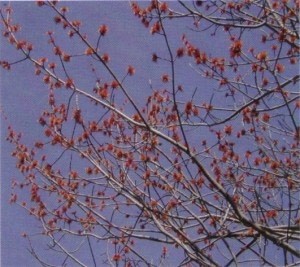We don’t want to shock the tourists, but the spring woods do bring some color beyond green. While spring displays of herbaceous plants flowering on the forest floor are a treat, there is much more to spring forest color than wildflowers alone. Yes, the trees produce color, too. Usually, you just have to look a little more carefully for it. But in some years, the colors of the spring forest canopy rival those of the more famous foliage of fall.
As trees break winter dormancy and their buds develop into various leaves, twigs, and flowers, the canopy across entire hillsides may change colors in varying combinations and intensities before it resumes full physiological function and settles in to your basic early summer green. This whole process – from first swelling of flower and leaf buds through fruiting and full leaf expansion – occurs over many weeks and offers a changing array of colors, depending on just about everything, from elevation and latitude to species mixes to previous and (especially) current growing conditions. The spring show features many varying shades and tones, from yellows and browns to pale green and even purple. But as in the more celebrated fall display, it is the reds – so distinct in a greenish world – that sometimes steal the spring show.
In forests heavy to red maple, for example, the canopy can appear downright crimson from late winter right through spring considering all the red twigs, red buds, and red flowers that are present even before the red maple leaves emerge.
But not all woods are dominated by red maple. According to Sandy Wilmot, a forest health specialist with the Vermont Department of Forests, Parks and Recreation, when entire forests of various hardwood species appear more red than green, it tends to occur later in spring, because it has more to do with leaves than twigs or flowers.
Wilmot and some of her colleagues with the Vermont Monitoring Cooperative came up with a system for tracking flower and leaf bud development in common hardwoods from the first bud swell to the last bud break. While most of us probably miss this process and some just enjoy that it’s happening, Wilmot and her colleagues observe and record it – every year. For example, in their studies of northern hardwood forests in Vermont, they document that the buds of red and sugar maple are the first to swell, followed by those of yellow birch and American beech, and, later, ash. While red maple starts earliest, it takes the longest to reach full leaf-out. Conversely, the late-starting ash finishes fastest. While these relative rankings hold from year to year, the actual dates can shift significantly, and that deviation can bring unusual color conditions from year to year.
“In 2002, for example, an early April heat wave triggered rapid leaf and flower development,” said Wilmot. But it was spring, after all; the heat wave faded and cold air returned. “Leaf development stalled and the partially emerged leaves had to withstand several weeks of cold.” This can be very dangerous for tender young leaves, and, as it turns out, it might explain those springs when there is more red than green in the canopy. And, get this: all that red may actually help protect those vulnerable young leaves.
Hardwood leaves are normally tinged with some red when they first appear. Gradually, they appear more greenish as they produce the all-important green pigment, chlorophyll. But this requires light and warmth. If those newly emerged leaves are greeted by a cold snap or prolonged cloud cover, they cannot make chlorophyll and will remain reddish for an extended period. This red color in spring leaves is due to the same pigments responsible for the brilliant reds of autumn, the anthocyanins. Scientists studying the physiology of fall foliage have suggested that the anthocyanins responsible for red color in leaves – in fall or spring – may help them withstand cold and screen them from damaging ultraviolet rays, air pollution, and various other assaults. This may not seem all that clever in an autumn leaf that’s about to drop, but in a spring leaf just getting started on a full growing season, it’s a brilliant strategy – especially considering all that could go wrong for a young leaf.
Ah, spring. Its visual charms may be a bit more subtle – some say pastel – than fall, but coming as they do after the drab browns and grays of mud season, the colors of the spring woods are just as good to see.



Discussion *